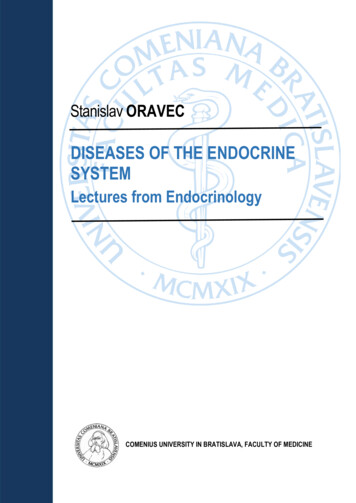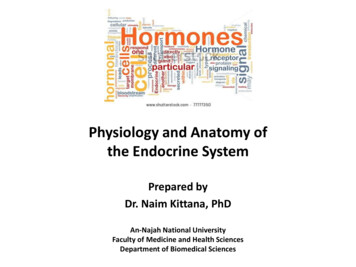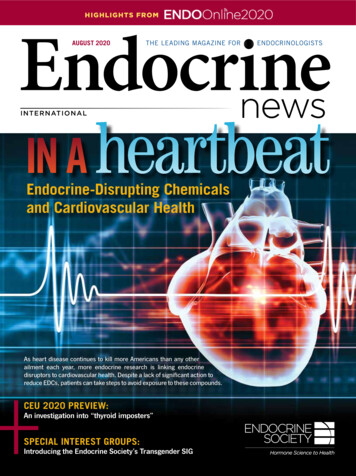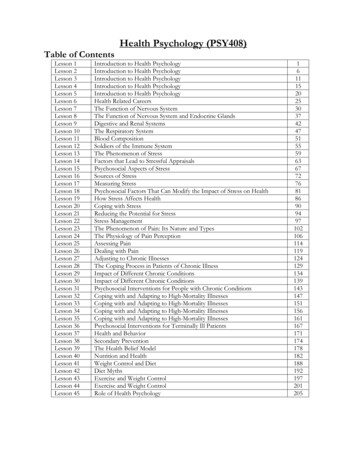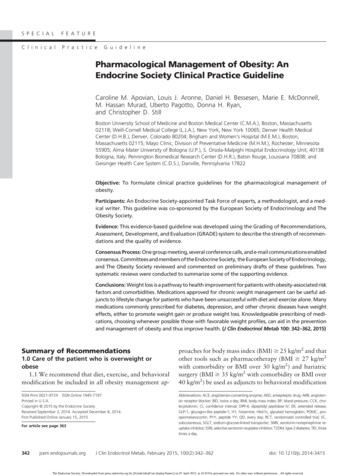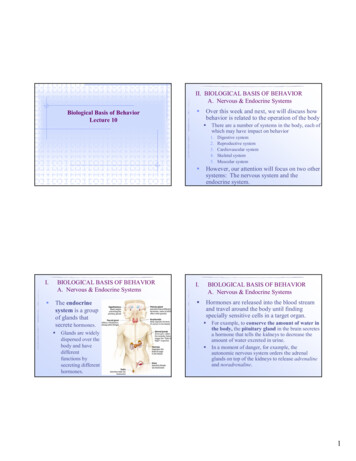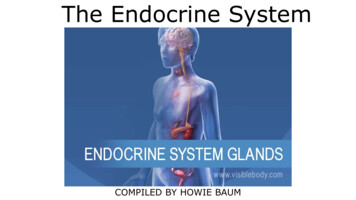
Transcription
The Endocrine SystemCOMPILED BY HOWIE BAUM
THE ENDOCRINE SYSTEMAlthough often overshadowed by the brain and nerves, the Endocrine system is alsoinvolved in the information business. Hormones carry essential messages that have farreaching effects.They control body processes at every level, from energy uptake of a single cell to the wholebody’s rate of growth and development.There are 50 of hormones, which are the body’s chemical messengers and theyare made by 12 different Endocrine glands.These glands have no ducts but secrete their hormones directly into the blood, bywhich means they reach every cell in the body.Hormones affect certain target tissues or organs and regulate their activities.
The Endocrine system sends hormones through the Circulatory system to control andcoordinate body functions in much the same way as the nervous system uses tiny electricalsignals. The Endocrine system and the Nervous system work together to integrate in thebrain and complement each other, but they tend to work at different speeds. Nerves respond within split-seconds but their action soon fades Some hormones have longer lasting effects and act over hours, weeks, andyears.Hormones regulate processes such as: The breakdown of chemical substances in metabolism of what we eat and drink Fluid balance and urine production The body’s growth and development Sexual reproduction.
THE 12 PARTS OF THEENDOCRINE SYSTEM
The hypothalamus and the pituitary gland are part of the diencephalon region of the brain.The hypothalamus connects the nervous system to the endocrine system. It receives andprocesses signals from other brain regions and pathways and translates them into hormones,the chemical messengers of the endocrine system.These hormones flow to the pituitary gland, which is connected to the hypothalamus by theinfundibulum. Some hormones are stored in the pituitary stores for later release; othersspur it to secrete its own hormones. The hormones released by the pituitary gland and thehypothalamus control the other endocrine glands and regulate all major internal functions.
The thymus gland producesprogenitor cells, whichmature into T-cells (thymusderived cells). The bodyuses T-cells to help destroyinfected or cancerous cells.T-cells created by thethymus also help otherorgans in the immunesystem grow properly.These cells are so vital,they are often donated tothose in need. TheThymus gland is theprimary donor of cells forthe lymphatic system,much as bone marrow isthe cell donor for thecardiovascular system.https://www.youtube.com/watch?v FW2Jat00lEs
THE ADRENAL GLANDS REGULATE SUBSTANCE LEVELS IN THE BLOOD ANDRELEASE “FIGHT-OR-FLIGHT” HORMONES
The adrenal glands are pyramid-shapedorgans that sit at the top of each kidney.Each adrenal gland consists of two structures: anouter adrenal cortex and an inner adrenal medulla.The adrenal cortex is a network of fine connectivetissues that makes up most of the gland. Itsecretes a range of steroid hormones.Cortisol which manages protein andglucose levels.Aldosterone which adjusts our levels ofwater and salt.Androgens and estrogens are secreted bythe adrenal cortex in small amounts byboth sexes.The adrenal medulla (inside the gland)produces epinephrine and nor-epinephrine(NE). These chemicals promote “fight-orflight,” the body’s initial response to stress.The left kidney is located slightly higherthan the right kidney due to the largersize of the liver on the right side of thebody
2 HORMONES MADE BY THE KIDNEYSThe kidneys make two main hormones, vitamin D and erythropoietin.Vitamin D is essential for a number of different functions in the body.Most of the vitamin D that is in the blood is inactive and it is modified by thekidney and other tissues to activate it.Active vitamin D stimulates the uptake of calcium from food, is important for themaintenance of healthy bones and also helps to regulate the response of theimmune system to infection.Erythropoietin is produced when oxygen levels in the blood are low.It acts in bone marrow to stimulate the production of mature red blood cells andto maintain healthy oxygen levels in our tissues.
SEX GLANDS AND HORMONESThe main sex glands are the ovaries infemales and testes in males.The sex hormones they produce stimulatethe production of eggs and spermrespectively and influence the earlydevelopment of the embryo into a boy orgirl.After birth, the circulating levels remain lowuntil puberty.Then, in males, the testes increase theiroutput of androgens (male sex hormones),such as testosterone.In females, the ovaries produce moreoestrogens and progesterone.
THE PINEAL GLANDThe pineal gland is small and pine coneshaped, (which is how it got its name)located at the back of the diencephalonregion in the brain.At night, in the absence of light, thepineal gland secretes the hormonemelatonin.Melatonin regulates the body’ssleep patterns in both circadian(daily) and seasonal patterns.In the morning, when light hits the eye,photo receptors in the retina sendsignals to the pineal gland, which thendecreases melatonin production and wewake up.
MASTER GLANDThe pituitary is the mostinfluential gland in the endocrinesystem.It is actually two distinct glands inone.Its front, or anterior lobemanufactures 7 major hormonesand releases them into thebloodstream.Behind it is the posterior (back) lobewhich receives its two mainhormones from the hypothalamus,which lies above it and then itreleases 3 hormones, as hormones#anterior-pituitary
PITUITARYGLANDThe Hypothalamus SendsHormones to the Pituitary Gland toControl the Endocrine System
THE THYROID AND PARATHYROID GLANDS INCREASE METABOLISMAND REGULATE CALCIUM LEVELS
THYROID GLANDThe thyroid gland sits in the throat region, justbelow the larynx, served by large arteries withmany branches and a dense network of capillaries.The hormones it secretes, travel in thebloodstream throughout the body to: Increase metabolism Regulate glucose use Protein synthesis Nervous system development. It also releases Calcitonin, which helpsmaintain blood calcium homeostasis bycausing calcium to be removed from ndsblood and deposited into bones when blood(calcium) levels are too high.
Parathyroid GlandsOn the posterior (back) surface of the thyroid sitmuch smaller, separate glands: the parathyroids.Typically there are four parathyroid glands, asuperior and inferior pair on the left and rightsides of the thyroid.They secrete parathyroid hormone (PTH),which stimulates bones to release calcium intothe blood when blood (calcium) levels are low.PTH also causes the kidneys to reduce calciumsecretion into urine to further elevate calciumlevels in the blood.Together, calcitonin and PTH act incomplementary ways to maintain bloodcalcium homeostasis, which is one of the mosttightly controlled physiological parameters inthe body.Go to 50 sechttps://www.youtube.com/watch?v qjHwOnV9K8A
Iodine is an element that's required forthe thyroid gland to produce thyroidhormones.Since the body does not produce iodine onits own, it needs to come from dietarysources—and striking the right balance is key.The Importance of IodineWhen you consume iodine, it is quicklyabsorbed and entered into your bloodstream.Your thyroid, which has tiny cells that capturethe circulating iodine, takes in and oxidizes itso it can begin to be used to createT3 and T4—thyroid hormones that make theirway throughout the body to regulatemetabolism and ensure healthy functioning ofthe heart, brain, and other organs.
GUT HORMONESThe gut hormones work in associationwith the gut’s extensive nervoussystem (enteric nervous system) andplay a coordinating role in: The control of appetite The digestion of food The regulation of energy balance The maintenance of blood glucoselevels.The gut continuously sends informationto the brain regarding the quality andquantity of the food that is consumed.
THE ROLE THAT SOME OF THESE HORMONES PLAY IS OUTLINED BELOW:Ghrelin is produced in the stomach, and its function is to tell the brain that the body has tobe fed. It increases appetite.Gastrin is produced in the stomach when it is stretched. It stimulates the release of gastricjuice rich in pepsin and hydrochloric acid.Secretin is produced in the duodenum and has the effect of stimulating the pancreas toproduce alkaline secretions as well as slowing the emptying of the stomach.Cholecystokinin (CCK) is produced in the duodenum. It reduces appetite, slows down theemptying of the stomach and stimulates the release of bile from the gall bladder.Peptide YY (PYY) is produced in the last part of the small intestine known as the ileum aswell as parts of the large intestine. It plays a role in slowing down the passage of food alongthe gut, which increases the efficiency of digestion and nutrient absorption after meal.Glucagon-like peptide 1 (GLP-1) is produced in the small intestine and colon and hasmultiple actions including inhibition of gastric emptying and appetite as well as thestimulation of insulin release.
PANCREAS – A DUAL-PURPOSE GLANDIt is also a part of the digestive system.It excretes pancreatic juice into the small intestine viathe pancreatic duct.Scattered within the pancreas there are also tinycell clusters called pancreatic islets (or islets ofLangerhans) that release hormones into thebloodstream.These islets make up less than 2% of pancreatic tissue,but their specialized cells regulate blood glucose levels(or blood sugar).When blood sugar is low, alpha cells in the isletsrelease glucagon. Glucagon spurs the liver tobreak down glycogen and release more glucoseinto the blood.When blood sugar is high, beta cells in the isletsrelease insulin, which increases glucose reuptake.https://www.youtube.com/watch?v qzjjW--I-2QThe Pancreas Regulates Blood SugarSurrounded by enzyme-producing acinicells, the tiny pancreatic islets containthree types of cells: alpha, beta, anddelta. The secretions of the latter helpregulate insulin and glucagon production.
A SUMMARY ABOUT THEENDOCRINE SYSTEMhttps://www.youtube.com/watch?v nCwRX7seya04.5 minutes
THANK YOU
The Endocrine system and the Nervous system work together to integrate in the brain and complement each other, but they tend to work at different speeds. Nerves respond within split -seconds but their action soon fades Some hormones have longer lasting effects and act over hour
